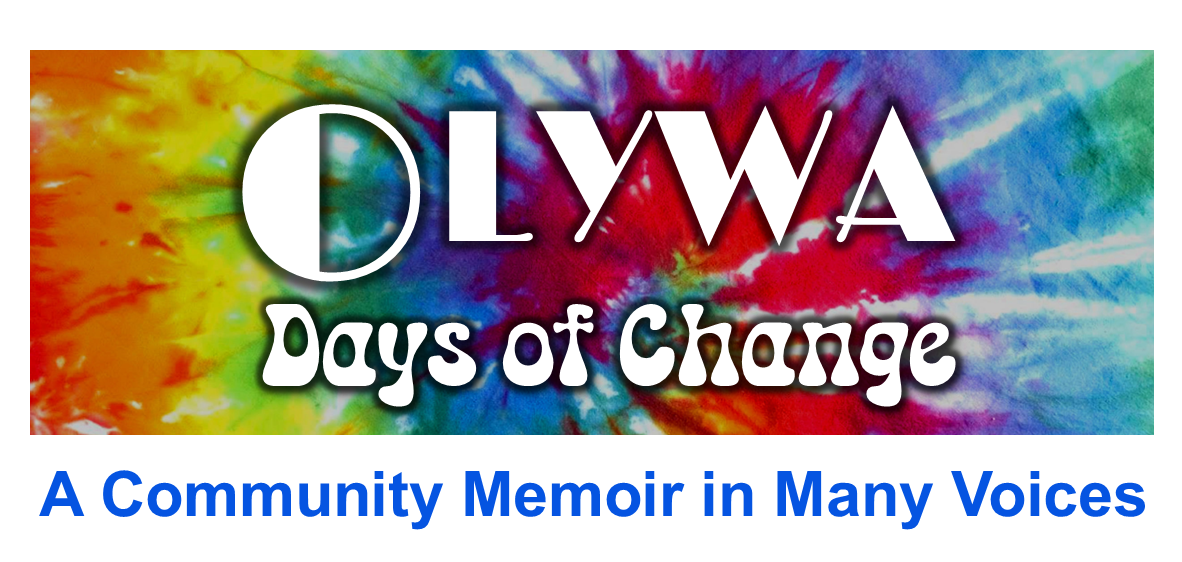ACTIVISM
A Small Town’s Sex-Positive Response to AIDS
By Don Orr Martin
This account uses fictionalized names and contains explicit images.
I’m betting that every town in America, large or small, has a secluded public spot where men have sex with each other. I won’t call them gay men because I know many do not consider themselves to be gay. They’re not looking for a relationship. Just a quickie. They seek anonymous, uncomplicated sex. The men who do this run the gamut—from poor to rich, from young to old, from Kinsey 1 to Kinsey 6. Some are married to women. Some view their urges as sinful. They stay hidden and repudiate the gay “lifestyle.” Others are openly gay and are past self-loathing. They may seek a sense of danger or a particular sexual kink. The practice has, no doubt, been going on for centuries, probably since the moment that same-sex encounters were made taboo and criminalized.
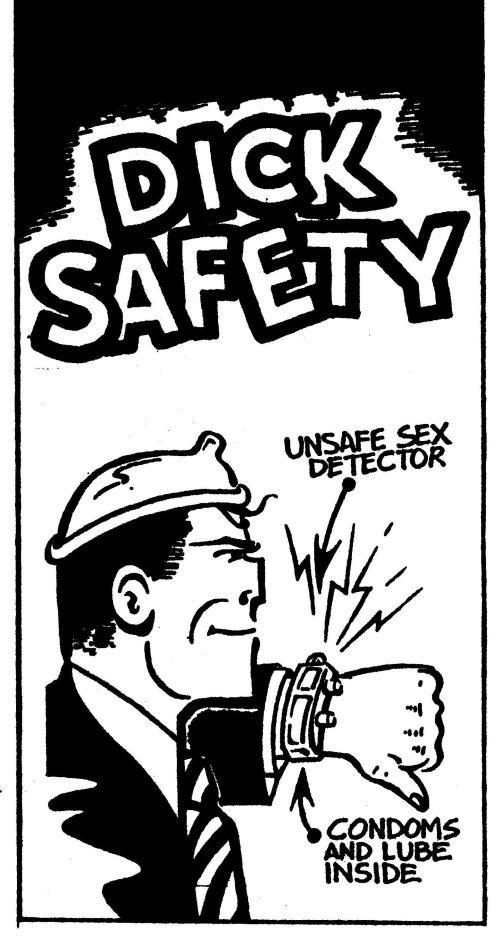
One such secluded place in my small town was a wooded area across from a city park beside the railroad tracks where no one would otherwise go. For years it was well-known and may still be. Before that, the popular spot had been a downtown restroom, until a prominent businessman and two government officials were entrapped there by the police. Consenting gay sex was decriminalized in Washington state in the mid-1970s, but it was still possible to ruin the lives of men by charging them with public indecency. The spot in the woods by the tracks was fairly discreet and mostly tolerated by the cops.
Then AIDS happened.
For years AIDS was seen as something that afflicted only homosexual men. Right-wing religious fanatics claimed the virus was a curse from god for violating biblical strictures. They blamed it on immorality, the result of the sexual revolution that embraced free love, birth control, and “deviance.” Conservative politicians exploited the fear of AIDS to rally their Christian soldiers and as a cash cow for election campaigns. They joked about faggots getting what they deserved, and they refused to adequately fund prevention efforts. This fear and loathing and ignorance further stigmatized the victims, drove them away from medical services, and helped spread the disease.
I worked in public health at the height of the AIDS pandemic. Powerful Republican congressmen and President Reagan’s agency heads put in place serious limits on what federally-funded educational programs could say about safe sex. Federal laws required that all the materials we produced about condom use and HIV testing had to include the message that the only ways to prevent AIDS or other sexually transmitted infections were by: 1) Abstinence; or 2) Fidelity in a heterosexual marriage. These were not messages that resonated with the men in the woods by the railroad tracks.
“It might be easier to reach these guys if we could talk about cum and butt fucking,” Bonnie Jefferson said to me. “Ah, now you’re blushing.” Bonnie was the main educator in the sexually transmitted disease section at the state Department of Health and my mentor. I was in health promotion, in charge of writing and designing educational materials. She’d been answering sex questions on the state’s hotline for twenty years. Oh my, the stories she told me.
She loved to make me blush. It didn’t take much. I never could control it. I was certainly no prude, but she found my easily-reddened face irresistible. Bonnie grew up on the streets of New York City. Nothing fazed her. She knew that the brochures on AIDS I helped her write and design had to follow federal prohibitions. She kept things factual, easy to understand, and unambiguous. Short sentences. Clear instructions. Pictures if possible. Fourth-grade reading level.
“I don’t care if we have to put in a disclaimer about abstinence and fidelity,” Bonnie said. “Most guys don’t even know what that means. What I care about is that they put the goddamn condom on before they stick it in whatever . . . oh, you’re blushing again.” I loved Bonnie. She was tough and funny. I think she took me under her wing because I was sincere, openly gay, and easy to tease. Plus, we had a mutual love of Broadway theater.
What Bonnie said, though, got me to thinking. Was there a better way to reach the population on which the disease was taking the biggest toll? The latest term was MSM—men who have sex with men. Was the credibility of the health department hurt by restrictive and judgmental federal language? Would it help to use humor? Would we reach more men with explicit images? No one had done studies on this yet. Outreach workers had hunches.
The gay community in the 1980s realized quickly that the government was only going to grudgingly help us fight this growing health crisis that was killing tens of thousands of MSMs. All across the country gay men and lesbian allies mobilized to find resources to care for the sick and dying. Act Up took to the streets and hit their mark in the media spotlight. Those of us in public health understood that our best contribution was to prevent infections. In my small town the vanguard of AIDS prevention was county health outreach workers. They had joined in the formation of a local AIDS task force. Most of them were gay. We all knew each other and donated our time and skills.
Randy Weller was new in town. He had just started working with the AIDS task force when he and I hooked up. We were both on the rebound from failed relationships, though neither of us had the inclination or the nerve to visit the woods by the tracks. In a small town, when a gay opportunity presents itself, you can’t be too coy. The sex came naturally for us. In one of our post-coital, late-night conversations Randy mentioned an idea for an outreach project he and a few other gay men were thinking about. I might be the perfect addition to the team.
The idea was a series of tiny cartoon leaflets, packaged in a baggie with free condoms and lube. The cartoons would have safe-sex messages and information on health services. Someone even came up with a name for the main character, Dick Safety. He would resemble the well-known comic cop Dick Tracy. But they needed an artist to draw the cartoons.
And so I was inducted into the gay cabal that included Greg Plumber and Steven Phillips who worked for the county health department, Tore Nelson and Terry Lunstrum, members of the taskforce, plus Randy and me. Greg was a long-time gay activist who I’d known for years. He was outgoing, ribald, and had a large ring piercing his columella. Steven was an AIDS counselor (in fact, Steven talked me through the terrifying process of getting my first HIV antibody test a couple of years earlier—such a compassionate and gentle man). Terry and Tore were beautiful blond partners eager to be on the front lines in the battle against AIDS.
We met at Greg’s apartment and brainstormed ideas for the cartoons. Hilarity ensued.
“Dick Safety needs to look like Dick Tracy, but not like a cop,” Terry said.
“The fedora has to go,” said Tore. “Too 1930s.”
“Maybe he should wear a condom on his head,” chuckled Randy. We all burst out laughing. Perfect.
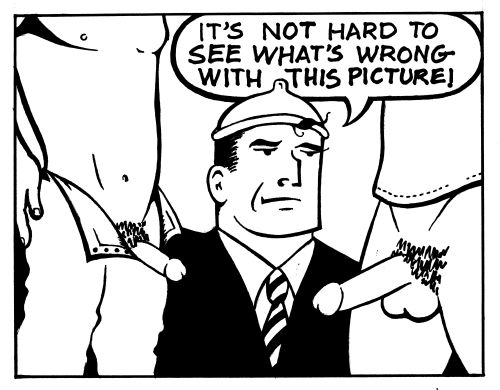
“I think it’s important that the comics be sex-positive,” said Steven.
“Yeah,” boomed Greg, “Lots of erect penises.” We all smacked our lips. I took notes and went home to sketch out some storyboards.
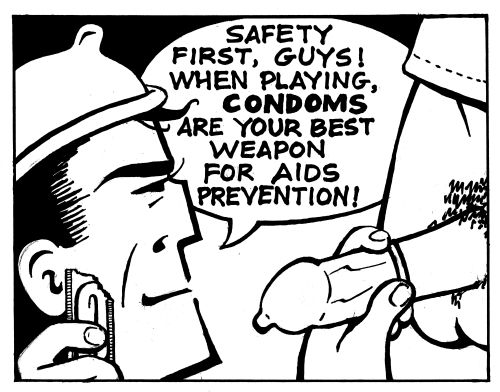
At the next meeting I presented my rough drawings. Everyone screamed. Dick Safety would be on the cover of each episode. In place of Tracy’s original TV wristwatch, our Dick had an Unsafe Sex Detector with a secret compartment for condoms and lube. In the first episode, his detector goes off, and he emerges from the bushes, coming to the rescue of two condomless guys. In another episode, Dick replaces an oil-based lubricant with a water-based brand for two men having sex in the back seat of a car. Dick Safety is never judgmental and seems to really relish his job.
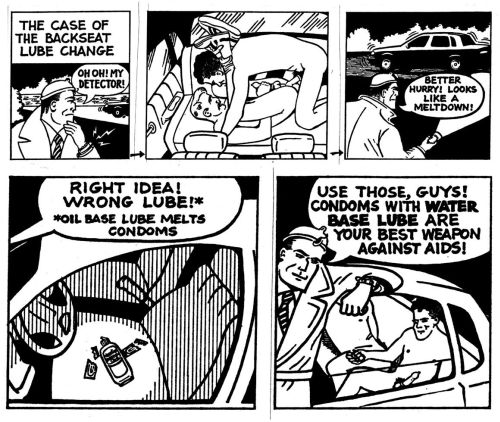
To be able to draw these comics, I had to do a lot of research on the style of the old Tracy cartoons and pore through tons of porn images to find traceable sex positions. At least that was my story, and I’m sticking to it. Randy would come over and help me select images and do the final inking. It was terribly sexy. I’m embarrassed to admit he and I sometimes did not follow our own advice on condom use.
Greg somehow managed to print the pornographic cartoons. Steven organized a crew to assemble the packets, and the county outreach workers discreetly handed them out to men they encountered down by the railroad tracks. Because the whole project was clandestine and could have gotten us government employees in trouble, we didn’t keep records or develop metrics for the effectiveness of our efforts. But the outreach workers reported positive responses.
One day I was sitting at my desk at the Department of Health, working on a brochure about smoking or nutrition or something, and Bonnie Jefferson came up behind me. “Have you seen these?” she said and threw a stack of Dick Safety comics on my keyboard. I turned bright red.
“I thought so.” She smiled.
We encourage readers to use the form below to make comments and suggestions. Disclaimer
